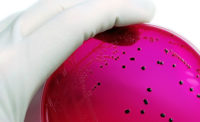Over the last two decades, the food industry has learned a tremendous amount about the potential dangers associated with Listeria in ready-to-eat (RTE) foods. As this knowledge has grown, more and more food companies are increasing testing in the food-processing environment and in finished products. With increased testing, however, Listeria is being detected more frequently. And, in many of these cases, when the presence of Listeria monocytogenes is confirmed, recalls are required. Since January, the presence of Listeria has led to the recall of approximately 50 million pounds of FSIS-regulated RTE food products.
In addition to meat and poultry products, many other products are being recalled for Listeria concerns as well. Recent major national recalls have involved products, produced by very sophisticated food companies, such as caramel apples, ice cream, cheese, packaged salads, frozen vegetables and sunflower kernels. What’s surprising in all of these cases, is that the manufacturers were all testing for and periodically finding Listeria in their processing environments. Although all of the food companies involved were also performing a root-cause analysis and also implementing corrective actions to deal with each of those findings, in every case this industry-accepted approach failed to prevent direct product contamination and a resulting massive recall.
What’s even more surprising is that each of these recalls could have been prevented.
This is because too many food companies defined the root cause of a positive Listeria finding as the failure to adequately clean the area that sampled positive. In turn, those companies have historically implemented corrective actions that only called for: (1) intensified cleaning and sanitization of the area in question; (2) retesting of the area that tested positive; and (3) employee retraining. Unfortunately, none of these companies were considering the root source of the problem.
Source is everything. When Listeria is identified in the processing environment, even at extremely low levels, it can quickly establish residence and intermittently contaminate finished products. Unless controlled, the resulting Listeria contamination can easily elude detection and also contaminate small amounts of finished product over long periods of time.
So, how can your company avoid becoming a victim? If you find Listeria in the environment, seek out and destroy its source. Rather than conducting a root cause analysis, conduct a root source analysis to identify and eliminate the bacteria that made its way into your facility.
Root out your Listeria, and you’ll root out your risk. NP





Report Abusive Comment